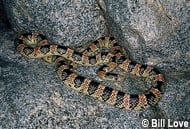Long-nosed Snake
Central California to Kansas, south through central Texas into northern Mexico and west to Baja California.
Long-nosed snakes are generally considered difficult to keep and are notorious escape artists. Keep specimens singly for best results. The snake should be given a terrarium of about body length with a loose sand bottom about 2 inches deep and a piece of bark or slightly raised rockwork. Newspaper also works well as a substrate. Captives seldom burrow. Terrarium temperatures should stay near 80 degrees Fahrenheit, dropping slightly at night to no lower than 70 degrees. A small heat lamp can be used to raise the temperature to no higher than 90 degrees during the day. Higher temperatures are dangerous. Provide only a small bowl of clean water to prevent terrarium humidity from rising to high levels.
Long-nosed snakes feed mostly on lizards, accepting anoles, skinks, fence lizards and other easily available species. Place a freshly-killed or living lizard in the terrarium just before the lights are turned off at night. Many specimens of long-nosed snakes can be taught to take pinky to hopper mice. After a specimen is feeding on lizards and established in the terrarium, dead mice rubbed with a lizard to transfer the scent can be offered at night. Alternate lizards and mice for a few meals until you are sure the snake will accept mice on a regular basis, but keep a few lizards in the freezer for possible changes in diet demands by the snake. Vet your specimen to reduce the number of intestinal worms. If wild-caught lizards are fed on a regular basis, parasites will reestablish themselves, so yearly worming is recommended.

